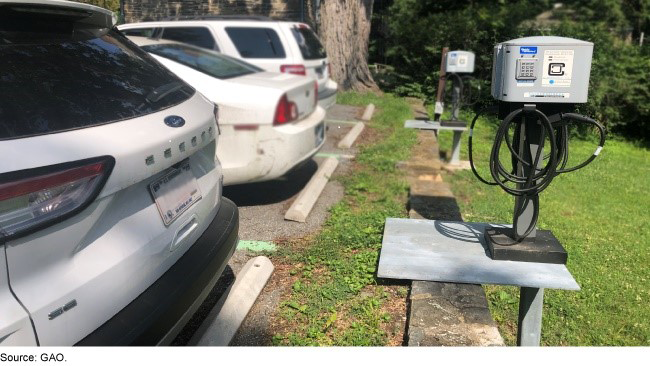Federal Vehicle Fleets: Observations on the Transition to Electric Vehicles
Fast Facts
In December 2021, the Biden Administration issued an Executive Order calling for most federal vehicle purchases to be zero-emission vehicles (such as electric vehicles) by 2035. This order affects about 380,000 federal vehicles as they need to be replaced.
Agencies may need to acquire about 30,000 zero-emission vehicles each year to meet future fleet requirements.
To support widespread electric vehicle use, the federal government may also need over 100,000 charging ports. As of August 2022, federal agencies owned and operated only about 4,000 charging ports.

Highlights
What GAO Found
A majority (about 69 percent) of vehicles owned and leased by federal agencies are classified as light-duty—mostly sport utility vehicles (SUVs), pick-up trucks, and sedans—and operated across the country. In fiscal year 2021, we found that agencies reported that federal vehicles traveled an average annual mileage of 6,000 miles—although this varied by type and the location of the vehicle. Over that same time period, less than 1 percent of federal vehicles were classified as zero-emission. A zero-emission vehicle is any vehicle, such as an electric vehicle, that, when operating, produces zero tailpipe exhaust emissions of certain pollutants or greenhouse gases.
While electric vehicle models are expected to become increasingly available, agencies may need to increase their acquisition of zero-emission vehicles by about 30,000 vehicles per year to meet Executive Order requirements. Given the types of vehicles that federal fleets operate and how they are used, agencies have the potential to incorporate these types of vehicles into their fleets. For example, light-duty vehicles are relatively likely to have a comparably sized zero-emission vehicle model available. GSA officials said that they have been unable to offer larger models of SUVs and pick-up trucks in the past. However, they said that they are optimistic that there will be electric vehicle options for all light-duty vehicle types within the next 5 years. In addition, agencies' typical use (i.e., annual mileage) of their vehicles also suggests a potential to transition to electric vehicles. Recent models of plug-in hybrid electric vehicles, which are powered by a combination of a battery on board and a gasoline engine, and of battery electric vehicles, which are powered solely by a battery on board, can generally drive farther than 40 miles and 200 miles, respectively, on battery power.
However, access to electric-vehicle-charging infrastructure is generally limited at federal facilities, and widespread fleet electrification will require a significant investment. To support widespread electric vehicle use, GSA has estimated that the federal government may need over 100,000 charging ports—the unit that provides power to the vehicle—in part, because GSA expects agencies to need one charging port for every two electric vehicles acquired—although the exact number required would depend on details of vehicle use and access to public-charging infrastructure. As of March 2022, federal agencies owned and operated over 4,000 charging ports—based out of about 1,050 charging locations—in less than 500 cities.
Why GAO Did This Study
In December 2021, the Biden Administration issued an Executive Order calling for all affected federal vehicle acquisitions to be zero-emission vehicles, such as electric vehicles, by 2035, including 100 percent zero-emission light-duty vehicle acquisitions beginning in 2027. This order affects approximately 380,000 vehicles within federal fleets as they become subject to replacement. Electrifying these fleets represents a significant transformation in the federal government's approach to vehicle procurement and will require a shift in perceptions about their capability to adequately meet mission needs in terms of performance and driving range. GSA and the Department of Energy, among other agencies, play a role in assisting agencies in transitioning their fleets.
This report examines: (1) the composition, use, and location of federal fleets and (2) the potential of federal fleets to transition to zero-emission vehicles. To address these objectives we analyzed government-wide data on vehicles in federal agency fleets, and determined that these data were sufficiently reliable for providing high-level depictions of federal fleets, such as describing their overall composition and location. However, they may not be detailed or consistent enough to provide accurate and reliable vehicle-level analyses, such as day-to-day use. We also analyzed GSA information on the vehicles agencies can purchase or lease through GSA, including electric vehicles, and the vehicles agencies ordered in fiscal year 2021. To understand the status of electric vehicle charging infrastructure available to federal agencies, we analyzed data from DOE on federally owned charging stations across the continental United States. We also spoke to GSA and DOE officials about the policies and practices that may affect the transition to electric vehicles.
For more information, contact Catina Latham at (202) 512-2834 or lathamC@gao.gov.
